
Niagara Falls was the host city for this year’s Canadian Greenhouse
Conference, but Ottawa shared in the industry spotlight that week thanks
to a major funding announcement.
Niagara Falls was the host city for this year’s Canadian Greenhouse Conference, but Ottawa shared in the industry spotlight that week thanks to a major funding announcement.
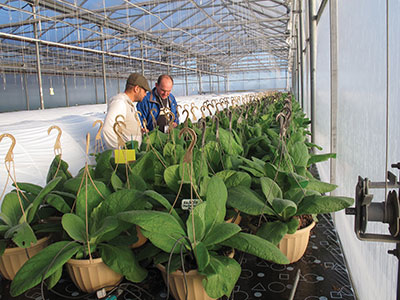 |
|
| BUS TOUR: Frisia Flora’s biocontrol program includes banker plants, including mullein plants and barley. Advertisement
|
Parliamentary Secretary Pierre Lemieux, representing Agriculture Minister Gerry Ritz, announced new funding of $2.7 million to the Ontario Greenhouse Vegetable Growers (OGVG). The announcement was made in a packed seminar room of growers attending the first day of the conference.
Among other projects, the funding will support research that will focus on improving the year-round production of greenhouse cucumber, pepper, and tomato crops, including improvements to yield and produce quality.
The project also will enhance the environmentally sustainable practices of greenhouse production.
“The goal is to provide Canadians with fresh, domestically grown produce in winter and help ensure the health and viability of the Canadian greenhouse veg sector,” said Lemieux. “By investing in research, we are helping growers harness innovation, so that this industry can continue to create jobs in Ontario and across the country.”
Agriculture and Agri-Food Canada (AAFC) researchers will collaborate on many of these projects, which include developing effective ways to guard against pests and diseases using biological control programs and developing ways to detect viruses in tomato and pepper crops.
“Adoption of the anticipated project outcomes by even 10 per cent of Ontario greenhouse vegetable farmers will result in a $20 million annual boost to the sector,” said OGVG chair Don Taylor.
The AgriInnovation Program is a five-year, up to $698-million initiative under the Growing Forward 2 policy framework.
(For more on the announcement, visit the news archives section at www.greenhousecanada.com.)
SOLD-OUT TRADE SHOW
This year’s conference, held at the Scotiabank Convention Centre, featured a sold-out trade show and solid crowds both days. Attendance was up a little this year compared to 2012.
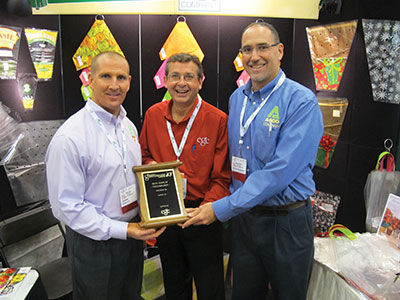 |
|
| BOOTH AWARD: The A Roo Company won the Small Booth Technology category in this year’s Best Booth awards. With committee member Wayne Brown are Kevin Shuman (at left) and Michael Poretsky (at right). |
|
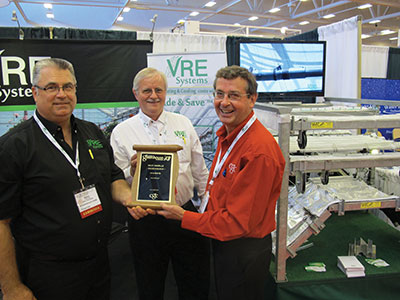 |
|
| BOOTH AWARD: VRE Systems won the Medium Booth Technology category. Committee representative Wayne Brown (at right) congratulates Mike Van Zalen (at left) and George Dekker (centre). | |
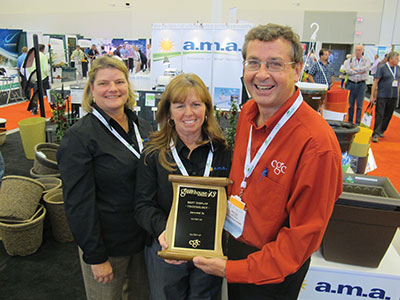 |
|
| BOOTH AWARD: Connie Bradt (at left) and Janan Alles of AMA Plastics accepted the Large Booth Technology award from CGC committee representative Wayne Brown. | |
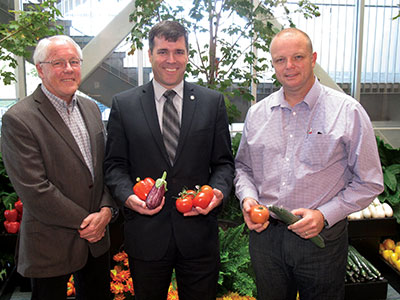 |
|
| OGVG chair Don Taylor, Parliamentary Assistant Pierre Lemieux, and Jan VanderHout, chair of The Ontario Greenhouse Alliance, take a closer look at one of the displays at this year’s Canadian Greenhouse Conference. | |
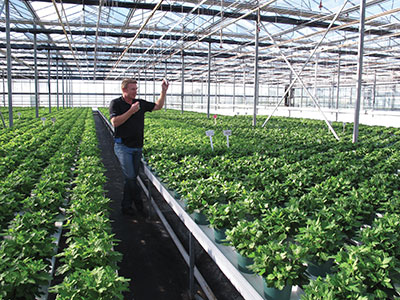
|
|
| BUS TOUR: Ed Boekestyn discussed the biocontrol program at Boekestyn Greenhouses, and the important role sachets play in ensuring effective predator populations are maintained. | |
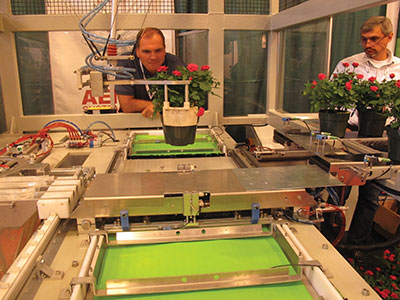 |
|
| ROBOTICS: John van de Vegte (at left), with VRIC’s packaging system. | |
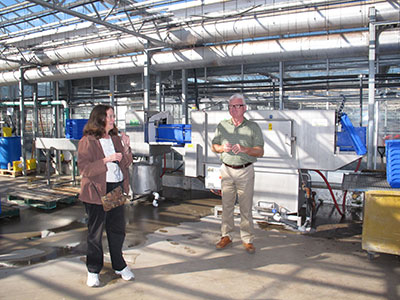 |
|
| BUS TOUR: Cart and tray washing units at Schenck Greenhouses; discussing their effectiveness are Cornell plant pathologist Margery Daughtrey and Lou Schenck. | |
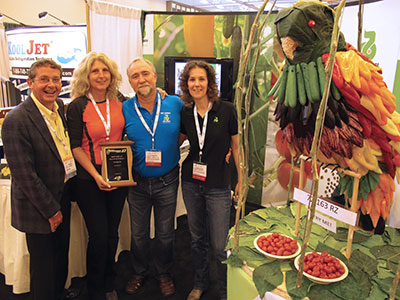 |
|
| BOOTH AWARD: RZH Canada Ltd. received the Small Booth Plant Material award. Wayne Brown makes the presentation to, left to right, Zora and Howard Huy, and Marlene van der Torre. | |
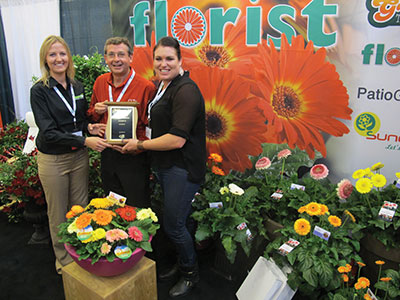 |
|
| BOOTH AWARD: Orchard Park Growers/Florist Holland Inc. won the Medium Booth Plant Material award. Wayne Brown congratulates Stephanie Hill (at left) and Felicia VanderVelde. | |
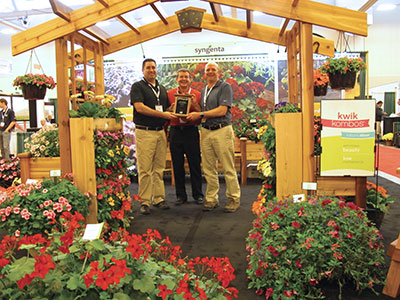 |
|
| BOOTH AWARD: Syngenta won the Large Booth Plant Material award. Wayne Brown makes the presentation to Sean Valk (at left) and Terry Talsma (at right). | |
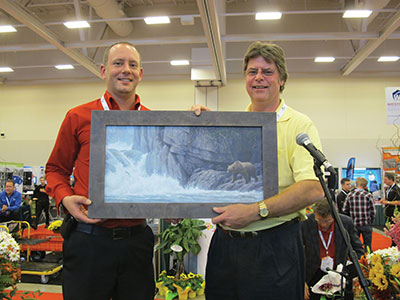 |
|
| Lorne King, at left, and Mark Crandon with the 2013 Volunteer Appreciation award. | |
The pre-conference bus tours were well received.
New this year was a two-day trip to the Leamington area, with visits to the Greenhouse and Processing Crops Research Centre, the Rijk Zwaan Demonstration Greenhouse, Golden Jem Produce, Southshore Greenhouses and Nature Fresh Farms.
The half-day ornamental Niagara region bus tour focused on pest and disease management strategies, with stops at Frisia Flora, Boekestyn Greenhouses, and Schenck Farms and Greenhouses.
Frisia Flora is a 30,000-square-foot greenhouse which specializes in mandevillas, lavender, rosemary and hydrangeas.
Sietse Elsinga (see photo at left) has been working with biocontrols for almost 15 years. He spends about two hours a week on the program. “I use a multi-prong approach,” he said. For example, eretmocerus, dicyphus and swirskii are all part of his whitefly control program.
Banker plants are extremely effective, and will even attract predators from outside the greenhouse. It’s important to hang them on dedicated drip lines to ensure they’re well watered.
For example, he uses mullein to rear Dicyphus hesperus, an omnivorous predator that is mainly used for whitefly control. However, it will also go after thrips and spider mites.
A barley hybrid is used in his aphid control program.
If you have to use chemicals, be sure they are biocompatible, he stressed. “If you have to use them, you have to use them. But we all hate spraying.”
Ed Boekestyn, of Boekestyn Greenhouses, said they have excellent results with their biocontrol program. Their main crops are potted mums and kalanchoes, along with seasonal crops such as Easter lilies and spring annuals.
They’ve been utilizing biocontrols for more than 10 years.
Their sachet release program is working especially well.
They key is to begin the program early in the crop cycle. When you have control, it’s easier to keep it, Boekestynnoted. But when you lose control, it takes a lot of extra work to regain the upper hand. “If we do experience problems, it’s usually because we weren’t proactive enough.”
Biocontrols may cost more than chemicals, he added, but chemicals don’t always work.
He suggested growers will experience a learning curve. “You have to work out a plan that works for you,” because what works for one grower might not work for another.” There’s no single recipe that everyone can use.
Lou Schenck welcomed the group to Schenck Farms and Greenhouses, a fourth-generation business. They handle a range of crops, including vegetative propagation (primarily geraniums), vegetative annuals, poinsettias, mums, begonia and gerbera, to name a few.
He demonstrated their cart washer unit, which helps ensure carts are thoroughly cleaned after being brought back from retailers. “It’s not perfect or 100 per cent, but we’re going a long way to minimize the problems associated with dirty plant material on our carts.”
They also have a tray washing system.
Plant pathologist Margery Daughtrey of Cornell University accompanied the tour to discuss various disease issues.
Environmental management is the best way to minimize botrytis pressure, she noted. “You want good plant spacing and good air movement. You want good condensation control in the crop so you can prevent the surface from being too wet. If the surface is wet for too long, there’s a good chance the spores will germinate and become a problem.”
To minimize pythium problems with poinsettias, she suggested growers choose varieties with vigorous root systems. Those varieties are not as prone to pythium as are varieties with less vigorous root systems. “Decide which root systems are better than others. Don’t just focus on the bracts.”
Drip irrigation reduces the likelihood of spreading pythium because there is no exchange of water from one plant to another. If they are grown on flood floors or benches, it’s important to get the timing right. If it’s done too long, the risk of spreading the disease increases.
PROTECTING THE GREAT LAKES
During the conference sessions, keynote speaker Dr. Saad Jasim, one of North America’s leading water quality specialists, tackled the topic of “Keeping Our Great Lakes Safe.”
In 2011, Lake Erie had one of the largest algal blooms in recent history. This excess algae, due in part to phosphorus inputs to the lake, has been steadily getting worse over the past decade.
Governments on both sides of the border are involved in water quality enhancement programs, with a number of joint programs.
The Great Lakes Basin is home to some 40 million people. The Great Lakes also has 20 per cent of the world’s fresh water supply.
Ozone treatments are one option to disinfect wastewater, said Dr. Jasim. It also puts more dissolved oxygen in the water.
BOOTH AWARDS
Winners in the Technology category of the booth awards included A-ROO (small booth), VRE Systems (medium size booth), and A.M.A. Plastics (large booth).
In the Plant Material category, the winners were RZH Canada Ltd. (small booth), Orchard Park Growers / Florist Holland Inc. (medium size booth), and Syngenta (large booth).
The Vineland Research and Innovation Centre booth attracted considerable attention both days of the show. John van de Vegte, manager of VRIC’s Robotics and Automation program, and several colleagues were on hand to demonstrate an automated packaging system for potted plants.
The goal is to handle 1,500 plants per hour.
The system performed flawlessly during the demonstrations, and large crowds assembled for each presentation. Automation is clearly a key focus for growers.
SPECIAL RECOGNITION
The CGC’s prestigious Volunteer Appreciation award was presented to Mark Crandon, national advertising manager for Greenhouse Canada and one of the longest serving trade fair committee members. Crandon is retiring from the magazine early in 2014.
Making the presentation was trade fair committee chairperson Lorne King.
Print this page